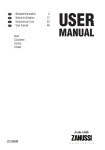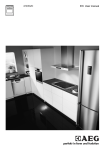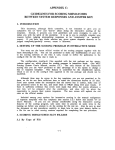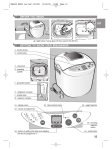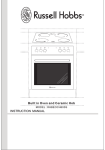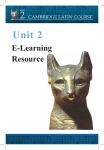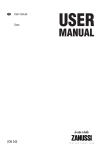Download Zanussi ZCV560M User manual
Transcript
EN User manual Cooker ZCV560M Contents Safety information _ _ _ _ _ _ _ _ _ _ _ _ _ _ _ _ _ _ Product description _ _ _ _ _ _ _ _ _ _ _ _ _ _ _ _ _ Before first use _ _ _ _ _ _ _ _ _ _ _ _ _ _ _ _ _ _ _ Hob - Daily Use _ _ _ _ _ _ _ _ _ _ _ _ _ _ _ _ _ _ _ Hob - Helpful hints and tips _ _ _ _ _ _ _ _ _ _ _ _ _ Hob - Care and Cleaning _ _ _ _ _ _ _ _ _ _ _ _ _ _ 2 4 5 5 6 6 Oven - Daily Use _ _ _ _ _ _ _ _ _ _ _ _ _ _ _ _ _ _ 6 Oven - Helpful hints and tips _ _ _ _ _ _ _ _ _ _ _ _ _ 7 Oven - Care and Cleaning _ _ _ _ _ _ _ _ _ _ _ _ _ 11 What to do if… _ _ _ _ _ _ _ _ _ _ _ _ _ _ _ _ _ _ 13 Installation _ _ _ _ _ _ _ _ _ _ _ _ _ _ _ _ _ _ _ _ 13 Environment concerns _ _ _ _ _ _ _ _ _ _ _ _ _ _ _ 14 Subject to change without notice Safety information Before the installation and use, read this manual carefully: • For your own safety and the safety of your property • For the protection of the environment • For the correct operation of the appliance. Always keep these instructions with the appliance also if you move or sell it. The manufacturer is not responsible if incorrect installation or use results in damage. Children and vulnerable people safety • This appliance can be used by children aged from 8 years and above and persons with reduced physical, sensory or mental capabilities or lack of experience and knowledge if they have been given supervision or instruction concerning use of the appliance in safe way and understand the hazards involved. Children shall not play with the appliance. • Keep all packaging away from children. There is the risk of suffocation or physical injury. • Keep children and animals away from the appliance when the door is open or the appliance is in operation. There is the risk of injury or other permanent disability. • If the appliance has Child lock or Key lock function, use it. It prevents children and animals from accidental operation of the appliance. General safety • Do not change the specifications of this appliance. There is the risk of injury and damage to the appliance. • Do not let the appliance stay unattended during operation. • Switch off the appliance after each use. Installation • Only an approved technician can install and connect the appliance. Contact an approved service centre. This 2 • • • • • • • is to prevent the risks of structural damage or physical injury. Make sure that the appliance is not damaged because of transport. Do not connect a damaged appliance. If necessary, contact the supplier. Remove all packaging, stickers and layers from the appliance before first use. Do not remove the rating plate. It can invalidate the guarantee. Fully obey the laws, ordinances, directives and standards in force in the country where you use the appliance (safety regulations, recycling regulations, electrical or gas safety rules etc.). Be careful when you move the appliance. The appliance is heavy. Always use safety gloves. Do not pull the appliance by the handle. Make sure that the appliance is disconnected from the power supply during the installation (if applicable). Keep the minimum distances to the other appliances and units. Do not put the appliance on a base. Electrical connection • Only an approved electrician can install and connect the appliance. Contact an approved service centre. This is to prevent the risks of structural damage or physical injury. • The appliance must be earthed. • Make sure that the electrical data on the rating plate agree with your domestic power supply. • Information on the voltage is on the rating plate. • You must have the correct isolation devices: line protecting cut-outs, fuses (screw type fuses removed from the holder), earth leakage trips and contactors. • The electrical installation must have an isolation device which lets you disconnect the appliance from the • • • • • • • • mains at all poles. The isolation device must have a contact opening width of minimum 3 mm. The shock protection parts must be fixed in such a way that they cannot be undone without tools. Always use a correctly installed shockproof socket. When you connect electrical appliances to mains sockets, do not let cables touch or come near the hot appliance door. Do not use multi-way plugs, connectors and extension cables. There is a risk of fire. Make sure not to squash or cause damage to the mains plug (if applicable) and cable behind the appliance. Make sure that the mains connection is accessible after the installation. Do not pull the mains cable to disconnect the appliance. Always pull the mains plug (if applicable). Do not replace or change the mains cable. Contact the service centre. Use • Only use the appliance for domestic cooking tasks. Do not use the appliance for commercial and industrial use. This is to prevent physical injury to persons or prevent damage to property. • Always monitor the appliance during operation. • Always stay away from the appliance when you open the door while the appliance is in operation. Hot steam can release. There is a risk of burns. • Do not use this appliance if it is in contact with water. Do not operate the appliance with wet hands. • Do not use the appliance as a work surface or storage surface. • The cooking surface of the appliance becomes hot during use. There is a risk of burns. Do not put metallic objects, for example cutlery or saucepans lids, on the surface, as they can become hot. • The interior of the appliance becomes hot during use. There is a risk of burns. Use gloves when you insert or remove the accessories or pots. • Open the door carefully. The use of ingredients with alcohol can cause a mixture of alcohol and air. There is the risk of fire. • Do not let sparks or open flames come near the appliance when you open the door. • Do not put flammable products or items that are wet with flammable products, and/or fusible objects (made • • • • • • • • • • • • • • • of plastic or aluminium) in, near or on the appliance. There is a risk of explosion or fire. Set the cooking zones to "off" after each use. Do not use the cooking zones with empty cookware or without cookware Do not let cookware boil dry. This can cause damage to the cookware and hob surface. If an object or cookware falls on the hob surface, the surface can be damaged. Do not put hot cookware near to the control panel because the heat can cause a damage to the appliance. Be careful when you remove or install the accessories to prevent damage to the appliance enamel. Cookware made of cast iron, cast aluminium or with damaged bottoms can scratch the hob surface if you move them on the surface. Discoloration of the enamel has no effect on the performance of the appliance. To prevent damage or discoloration to the enamel: – do not put any objects directly on the appliance floor and do not cover it with aluminium foil; – do not put hot water directly into the appliance; – do not keep moist dishes and food in the appliance after you finish the cooking. Do not apply pressure on the open door. Do not put flammable materials in the compartment below the oven. Keep there only heat-resistant accessories (if applicable). Do not cover oven steam outlets. They are at the rear side of the top surface (if applicable). If there is a crack on the surface, disconnect the power supply. There is a risk of electric shock. Do not put heat-conducting materials (e.g. thin metal mesh or metal-plated heat conductors) under the cookware. Excessive heat reflection can damage the cooking surface. Do not use the appliance during a power cut. Care and cleaning • Before maintenance, make sure that the appliance is cold. There is a risk of burns. There is a risk that the glass panels can break. • Keep the appliance clean at all times. A build-up of fats or other foodstuff can result in a fire. 3 • Regular cleaning prevents the surface material from deteriorating. • For your personal safety and the safety of your property, only clean the appliance with water and soap. Do not use flammable products or products that can cause corrosion. • Do not clean the appliance with steam cleaners, highpressure cleaners, sharp objects, abrasive cleaning agents, abrasive sponges and stain removers. • If you use an oven spray, follow the instructions from the manufacturer. Do not spray anything on the heating elements and the thermostat sensor (if applicable). • Do not clean the glass door with abrasive cleaning agents or metal scraper. Heat resistant surface of the inner glass can break and shatter. • When the door glass panels are damaged they become weak and can break. You must replace them. Contact the service centre. • Be careful when you remove the door from the appliance. The door is heavy. • Bulb lamps used in this appliance are special lamps selected for household appliances use only. They can- not be used for the full or partial illumination of a household room. • If it becomes necessary to replace the lamp use one of the same power and specifically designed for household appliances only. • Disconnect the appliance from the power supply before the replacement of the oven lamp. There is the risk of electrical shock. Cool down the appliance. There is a risk of burns. Service centre • Only an approved engineer can repair or work on the appliance. Contact an approved service centre. • Use only original spare parts. Disposal of the appliance • To prevent the risk of physical injury or damage: – Disconnect the appliance from the power supply. – Cut off the mains cable and discard it. – Discard the door catch. This prevents children or small animals from being closed inside of the appliance. There is a risk of suffocation. Product description General overview 2 1 3 2 1 11 4 4 5 6 7 4 12 3 8 9 10 1 2 3 4 5 6 7 8 9 10 11 12 Control panel Cooking zones indicators Knob for oven temperature Temperature indicator Hob indicator Knob for oven functions Knobs for the hob Grill Oven lamp Fan Rating plate Shelf runner Cooking surface layout 1 2 140 180 mm mm 180 140 mm 5 1 2 3 4 5 Single cooking zone 1200 W Single cooking zone 1800 W Single cooking zone 1200 W Residual heat indicator Single cooking zone 1800 W mm 4 3 Oven accessories • Oven shelf For cookware, cake tins, roasts. • Flat baking tray For cakes and biscuits. • Flat aluminized baking tray For cakes and biscuits. • Storage compartment Below the oven is the storage compartment. To use the compartment, lift the lower front door then pull down. Warning! The storage compartment can become hot when the appliance operates. Before first use Warning! Refer to "Safety information" chapter. Remove all packaging, both inside and outside the oven, before using the appliance. Do not remove the rating plate. Caution! To open the oven door, always hold the handle in the centre. Initial Cleaning • Remove all parts from the appliance. • Clean the appliance before first use. Preheating 1. 2. 3. and maximum temperature. Set function Run an empty oven for 45 minutes. and maximum temperature. Set function 4. Run an empty oven for 15 minutes. This is to burn off any residue from the cavity surface. Accessories can become more hot than in normal use. During this period an odour and smoke can be emitted. This is normal. Make sure the airflow is sufficient. Caution! Do not use abrasive cleaning agents! This can damage the surface. Refer to chapter "Care and Cleaning". Hob - Daily Use Warning! Refer to "Safety information" chapter. 5 Heat settings 2. Control knob 0 1-9 1. Function To complete the cooking process, turn the control knob to the “0” position. If all cooking zones are deactivated, the hob control indicator goes out. Off position Residual heat indicator Heat settings (1 = lowest heat setting; 9= highest heat setting) The residual heat indicator comes on when a cooking zone is hot. Warning! Risk of burns from residual heat! Turn the control knob to a necessary heat setting. The hob control indicator comes on. Hob - Helpful hints and tips Cookware • Put cookware on a cooking zone before you start it. • Stop the cooking zones before the end of the cooking time to use residual heat. • The bottom of pans and cooking zones must have the same dimension. • The bottom of the cookware must be as thick and flat as possible. • Cookware made of enamelled steel and with aluminium or copper bottoms can cause discoloration on glass ceramic surface. Energy saving • If possible, always put the lids on the cookware. Hob - Care and Cleaning Warning! Refer to "Safety information" chapter. Clean the appliance after each use. Always use cookware with clean bottom. Scratches or dark stains on the glass ceramic have no effect on how the appliance operates. To remove the dirt: 1. – Remove immediately:melted plastic, plastic foil, and food with sugar. If not, the dirt can cause damage to the appliance. Use a special scraper for the glass . Put the scraper on the glass surface at an acute angle and move the blade on the surface . 2. 3. • • • – Remove after the appliance is sufficiently cool:limescale rings , water rings, fat stains, shiny metallic discolorations. Use a special cleaning agent for glass ceramic or stainless steel. Clean the appliance with a moist cloth and some detergent. At the end rub the appliance dry with a clean cloth. Clean the front of the appliance with a soft cloth and a solution of hot water and some detergent. For metal fronts use some detergent for stainless steel. Do not use scouring agents and abrasive sponges. Oven - Daily Use Warning! Refer to "Safety information" chapter. Activating and deactivating the appliance 1. 6 Turn the oven functions control knob to an oven function. 2. Turn the temperature control knob to a temperature. The temperature indicator comes on while the temperature in the appliance increases. 3. To deactivate the appliance, turn the oven functions control knob and the temperature control knob to the Off position. safety thermostat, which interrupts the power supply. The oven switches back on again automatically, when the temperature drops. Safety thermostat To prevent dangerous overheating (due to incorrect use of the appliance or defective components), the oven has a The oven functions Oven functions Application The oven is OFF Conventional cooking Heats both from the top and bottom element. To bake and roast on one oven level. Full grill The full grill element is on. To grill flat food items in large quantities. To make toasts. Maximum temperature for this function is 210 °C Bottom heating element Heats only from the bottom of the oven. To bake cakes with crispy or crusty bases. Fan forced cooking To roast or roast and bake the food that requires the same cooking temperature, using more than one shelf, without flavour transference. Pizza economic To roast or roast and bake the food quickly on one level, using grill and bottom elements assisted by fan. Oven - Helpful hints and tips • The appliance has four shelf levels. Count the shelf levels from the bottom of the appliance floor. • You can cook different dishes on two levels at the same time. Place the shelves on level 1 and 3. • Moisture can condense in the appliance or on the glass doors. This is normal. Always stand back form the appliance when you open the appliance door while cooking. To decrease the condensation, run the appliance for 10 minutes before cooking. • Wipe away moisture after every use of the appliance. • Do not put the objects directly on the appliance floor and do not cover the components with aluminium foil when you cook. This can change the baking results and damage the enamel coating. Baking cakes • Preheat the oven for approximately 10 minutes before baking. • Do not open the oven door before 3/4 of the set cooking time is up. • If you use two baking trays at the same time, keep one level empty between them. Cooking meat and fish • Do not cook meat with weight below 1 kg. Cooking too small quantities makes the meat too dry. • Use a dripping pan for very fatty food to prevent the oven from stains that can be permanent. • Leave the meat for approximately 15 minutes before carving so that the juice does not seep out. • To prevent too much smoke in the oven during roasting, add some water into the dripping pan. To prevent the smoke condensation, add water each time after it dries up. 7 Cooking times cookware, recipes and quantities when you use this appliance. Cooking times depend on the type of food, its consistency, and volume. Initially, monitor the performance when you cook. Find the best settings (heat setting, cooking time, etc.) for your Conventional cooking Shelf level Preheating time (minutes) Temperature (°C) Cooking / baking time (minutes) enamelled 3 - 150 25-30 1000 enamelled 2 10 160-170 30-35 2000 enamelled 3 - 170-190 40-50 2 round aluminized trays (diameter: 20 cm) 1 15 180-200 50-60 Food Weight (g) Pastry stripes 250 Flat cake Yeast cake with apples Apple pie 1200+1200 Tray type Small cakes 500 enamelled 2 10 160-180 25-30 Fatless sponge cake 350 1 round aluminized tray (diameter: 26 cm) 1 10 160-170 25-30 Drip pan cake 1500 enamelled 2 - 160-170 45-551) Chicken, whole 1350 oven shelf at level 2, roasting tray at level 1 2 - 200-220 60-70 Chicken, half 1300 oven shelf at level 3, roasting tray at level 1 3 - 190-210 30-35 Pork roast cutlet 600 oven shelf at level 3, roasting tray at level 1 3 - 190-210 30-35 Flan bread 800 enamelled 2 20 230-250 10-15 Stuffed yeast cake 1200 enamelled 2 10-15 170-180 25-35 Pizza 1000 enamelled 2 10-15 200-220 30-40 Cheese cake 2600 enamelled 2 - 170-190 60-70 8 Food Weight (g) Tray type Shelf level Preheating time (minutes) Temperature (°C) Cooking / baking time (minutes) Swiss apple flan 1900 enamelled 1 10-15 200-220 30-40 Christmas cake 2400 enamelled 2 10-15 170-180 55-652) Quiche Lorraine 1000 1 round tray (diameter: 26 cm) 1 10-15 220-230 40-50 Peasant bread 750+750 2 round aluminized trays (diameter: 20 cm) 1 183) 180-200 60-70 Romanian sponge cake 600+600 2 round aluminized trays (diameter: 25 cm) 2/2 10 160-170 40-50 Romanian sponge cake traditional 600+600 2 round aluminized trays (diameter: 20 cm) 2/2 - 160-170 30-40 Yeast buns 800 enamelled 2 10-15 200-210 10-15 Swiss roll 500 enamelled 1 10 150-170 15-20 Meringue 400 enamelled 2 - 100-120 40-50 Crumble cake 1500 enamelled 3 10-15 180-190 25-35 Sponge cake 600 enamelled 3 10 160-170 25-35 Buttered cake 600 enamelled 2 10 180-200 20-25 Shelf level Preheating time (minutes) Temperature (°C) Cooking / baking time (minutes) 3 10 140-150 20-30 1) After you switch off the appliance, leave the cake in the oven for 7 minutes. 2) After you switch off the appliance, leave the cake in the oven for 10 minutes. 3) Set the temperature to 250 °C for preheating. Fan forced cooking Food Weight (g) Pastry stripes 250 enamelled Pastry stripes 250 + 250 enamelled 1/3 10 140-150 25-30 Pastry stripes 250 + 250 + 250 enamelled 1/2/3 10 150-160 30-40 500 enamelled 2 10 150-160 30-35 Flat cake Tray type 9 Food Weight (g) Tray type Shelf level Preheating time (minutes) Temperature (°C) Cooking / baking time (minutes) Flat cake 500 + 500 enamelled 1/3 10 150-160 35-45 Flat cake 500 + 500 + 500 enamelled 1/2/41) 10 155-165 40-50 2000 enamelled 3 - 170-180 40-50 2/2 - 165-175 50-60 Yeast cake with apples Apple pie Small cakes 1200 + 1200 2 round aluminized trays (diameter: 20 cm) 500 enamelled 2 10 150-160 20-30 Small cakes 500 + 500 enamelled 1/3 10 150-160 30-40 Small cakes 500 + 500 + 500 enamelled 1/2/41) 10 150-160 35-45 Fatless sponge cake 350 1 round aluminized tray (diameter: 26 cm) 1 10 150-160 20-30 Drip pan cake 1200 enamelled 2 - 150-160 30-352) Chicken, whole 1300 oven shelf at level 2, roasting tray at level 1 2 - 170-180 40-50 Pork roast 800 oven shelf at level 2, roasting tray at level 1 2 - 170-180 45-50 Stuffed yeast cake 1200 enamelled 2 20-30 150-160 20-30 Pizza 1000 + 1000 enamelled 1/3 - 180-200 30-40 Pizza 1000 enamelled 2 - 190-200 25-35 Cheese cake 2600 enamelled 1 - 160-170 40-50 Swiss apple flan 1900 enamelled 2 10-15 180-200 30-40 Christmas cake 2400 enamelled 2 10 150-160 35-402) Quiche Lorraine 1000 1 round tray (diameter: 26 cm) 2 10-15 190-210 30-40 10 Food Weight (g) Tray type Shelf level Preheating time (minutes) Temperature (°C) Cooking / baking time (minutes) Peasant bread 750+750 2 round aluminized trays (diameter: 20 cm) 1 15-203) 160-170 40-50 Romanian sponge cake 600+600 2 round aluminized trays (diameter: 25 cm) 2/2 10-15 155-165 40-50 Romanian sponge cake traditional 600+600 2 round aluminized trays (diameter: 20 cm) 2/2 - 150-160 30-40 Yeast buns 800 enamelled 3 15 180-200 10-15 Yeast buns 800 + 800 enamelled 1/3 15 180-200 15-20 Swiss roll 500 enamelled 3 10 150-160 15-25 Meringue 400 enamelled 2 - 110-120 30-40 Meringue 400 + 400 enamelled 1/3 - 110-120 45-55 Meringue 400 + 400 + 400 enamelled 1/2/41) - 115-125 55-65 1500 enamelled 3 - 160-170 25-35 Sponge cake 600 enamelled 2 10 150-160 25-35 Buttered cake 600 + 600 enamelled 1/3 10 160-170 25-35 Crumble cake 1) After the cake at level 4 is done, take it out and put in the cake from level 1. Bake for ten more minutes. 2) After you switch off the appliance, leave the cake in the oven for 7 minutes. 3) Set the temperature to 250 °C for preheating. Pizza economic Weight (g) Shelf level Pre-heating time (minutes) Temperature (°C) Cooking / baking time (minutes) Tray type Pizza 1000 1 - 200-210 20-30 enamelled Pizza 1000 + 1000 1/2 - 180-200 30 level 2 enamelled, level 1 aluminized1) Food 1) After 20 minutes, switch the trays between the levels. Oven - Care and Cleaning Warning! Refer to "Safety information" chapter. 11 • Clean the front of the appliance with a soft cloth with warm water and cleaning agent. • To clean metal surfaces use a usual cleaning agent • Clean the oven interior after each use. Thus you can remove dirt more easily and it does not burn on. • Clean stubborn dirt with a special oven cleaner. • Clean all oven accessories (with a soft cloth with warm water and cleaning agent) after each use and let them dry. • If you have nonstick accessories, do not clean them using an aggressive agents, sharp edged objects or dishwasher. It can destroy nonstick coating! Cleaning the oven door 1 1 3 Close the oven door to the first opening position (halfway). Then pull forward and remove it from its seat. The oven door has two panels of glass installed one behind the other. To make the cleaning easier remove the oven door and the internal panel of glass. Warning! The oven door can close if you try to remove the internal panel of glass when the door is still assembled. Important! Do not loose the screws 3 2 2 Warning! Make sure that the glass panels are cool, before you clean the glass door. There is risk that the glass breaks. Warning! When the door glass panels are damaged or have scratches, the glass becomes weak and can break. To prevent this you must replace them. For more instructions, contact your local Service Centre. Removing the oven door and the glass panel 4 Place the door on a stable surface protected by a soft cloth. Use a screwdriver to remove 2 screws from bottom edge of door 6 Lift the inner door 7 Clean inner side of the door Clean the glass panel with water and soap. Dry it carefully. 5 Use a spatula made of wood or plastic or equivalent to open the inner door Hold the outer door, and push the inner door against the top edge of the door Warning! Only clean the glass panel with water and a soap. Abrasive cleaning agents, stain removers and sharp objects (e.g. knives or scrapers) can cause damage to the glass. Inserting the door and the glass panel 1 Open the door fully and hold the two door hinges. 12 2 Lift and turn the levers on the two hinges. When the cleaning procedure is completed, insert the oven door. To do so, do the steps in opposite way. • Remove the fuses in the fuse box or switch off the circuit breaker. 4 4 6 Put a cloth on the bottom of the oven for protection of the oven light and glass cover. 5 Replacing the oven light bulb/cleaning the glass cover 1. Turn the glass cover anti-clockwise to remove it. 2. Clean the glass cover. 3. Replace the oven light bulb with applicable 300°C heat-resistant oven light bulb. 4. Install the glass cover. 5 Oven lamp Warning! There is a danger of electrical shock! Before you change the oven lamp: • Switch off the oven. What to do if… Problem Possible cause The residual heat indicators does not come on The cooking zone is not hot because it operated only for a short time If the cooking zone must be hot, speak to the after sales service The appliance does not operate The fuse in the fuse box is released Control the fuse. If the fuse is released more than one time, refer to a qualified electrician. The oven does not heat up The oven is not switched on Switch on the oven The oven does not heat up The necessary settings are not set Control the settings The oven lamp does not operate The oven lamp is defective Replace the oven lamp Steam and condensation settle on the food and in the oven cavity You left the dish in the oven for too long Do not leave the dishes in the oven for longer than 15-20 minutes after the cooking process ends If you cannot find a solution to the problem yourself, contact your dealer or the service centre. Remedy The necessary data for the service centre is on the rating plate. The rating plate is on the front frame of the oven cavity. We recommend that you write the data here: Model (MOD.) ......................................... Product number (PNC) ......................................... Serial number (S.N.) ......................................... Installation Warning! Refer to "Safety information" chapter. 13 Location of the appliance You can install your freestanding appliance with cabinets on one or two sides and in the corner. B A Dimensions Width 500 mm Depth 600 mm Total electricity power 8685 W Voltage 230 V Frequency 50 Hz Electrical installation The manufacturer is not responsible if you do not follow safety precautions from chapter "Safety information". This appliance is supplied without a main plug and a main cable. Applicable cable type: H05 RR-F with adequate cross-section. The power cable must not touch the part of the appliance shown in the illustration. Minimum distances Dimension mm A 690 B 150 Technical Data Appliance class 2, sub class 1 and class 1. Dimensions Height 858 mm Environment concerns The symbol on the product or on its packaging indicates that this product may not be treated as household waste. Instead it should be taken to the appropriate collection point for the recycling of electrical and electronic equipment. By ensuring this product is disposed of correctly, you will help prevent potential negative consequences for the environment and human health, which could otherwise be caused by inappropriate waste handling of this product. For more detailed information about recycling of this product, please contact 14 your local council, your household waste disposal service or the shop where you purchased the product. Packaging material The packaging material is environmentally-friendly and recyclable. Plastic parts are marked with international abbreviations such as PE, PS, etc. Dispose of the packaging material in the containers provided for this purpose at your local waste management facility. Warning! Your appliance should be made inoperable before it is disposed of, so that it does not constitute a danger. To do this, take the mains plug from the socket and remove the mains cable from the appliance. 15 892944125-B-132011 www.zanussi.com/shop
















